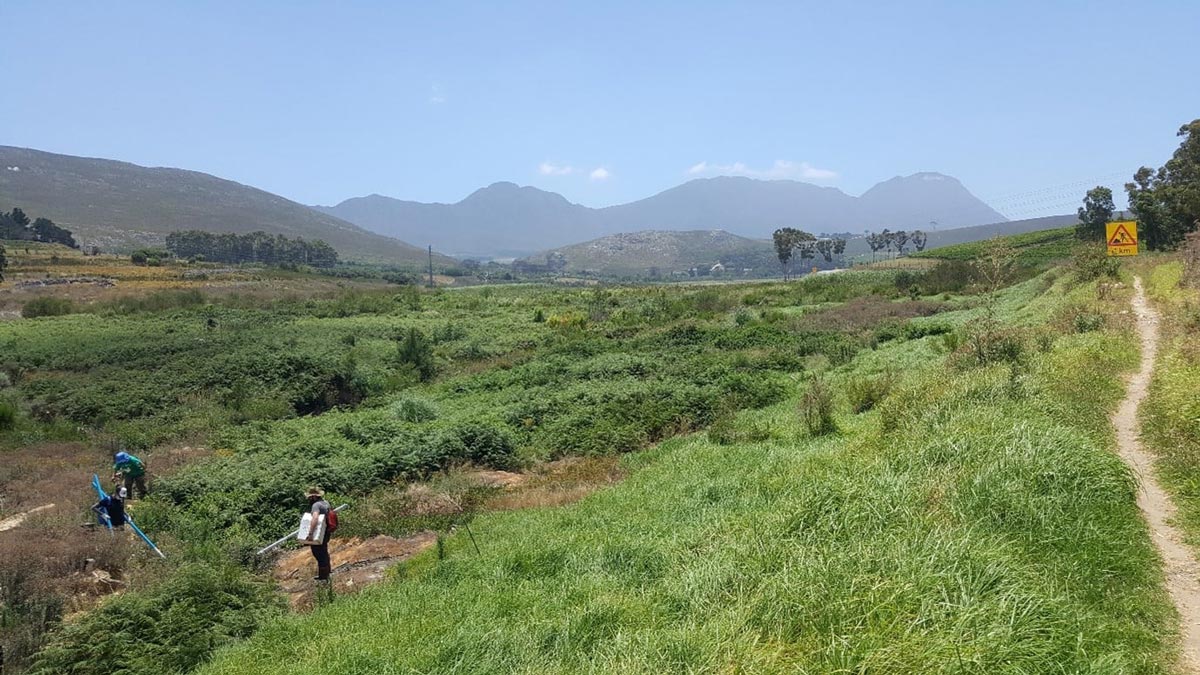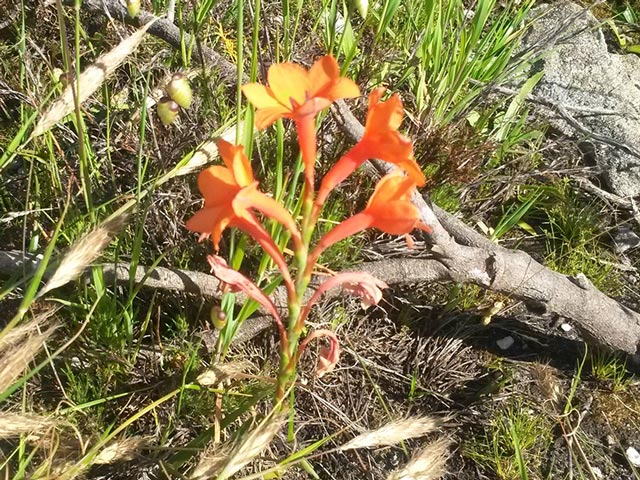Overstrand Celebrates Unique Peatlands on World Wetlands day
Top Image: The team inspecting a site to install a piezometer nest along a transect at the Onrus River Palmiet Peatland during the week of 17-21 January 2022.
(Photo: AT Grundling)
On 2 February 2022, Overstrand Municipality joined the rest of the world in celebrating World Wetlands Day with a site visit to the Onrus River Palmiet Peatland in the Hemel-en-Aarde Valley.
What makes this ± 33ha wetland so unique, is that it contains a thick layer of peat (6 to 8 m) and is covered by endemic vegetation (i.e. Palmiet plant, Prionium serratum) which formed the upper peat layers. Peat (organic material with a high carbon content), accumulates over thousands of years.
The Palmiet plant, performs an essential ecosystem service and plays a critical role in the functioning of the Onrus River and the Onrus Estuary. Simply put, this wetland is the only upstream natural filtering system that keeps the Onrus Estuary in balance. Palmiet is robust and slows down water flow and forms peat, while the peatland stores water and carbon.
The Onrus River Palmiet Peatland became known after the devastating fires that raged in the Overstrand during January 2019, which included the smouldering sites along the Onrus River in close proximity to the Camphill School and Camphill Farm Community.
The sub-surface fire along this section of the Onrus River burnt from 11 January 2019 till July 2019 when the fire was eventually contained. The site was monitored for any flare-ups until 5 February 2020 when the Onrus River Palmiet Peatland fire was officially declared safe. The underground fire did not only destroy large section of peat soil, it also created a substantial amount of smoke that significantly affected the air quality of the area and had a detrimental effect on the health of residents in the valley.
“We had to bring in a peat specialist, Dr Piet-Louis Grundling from the National Working for Wetlands Programme, which is a is an initiative of Department of Forestry, Fisheries and the Environment (DFFE), and a fire specialist Martin Bolton from the National Working on Fire Programme to assist and to find a workable way forward to douse the underground fire. In partnership with these specialists and other government organisations and affected landowners, a specialised fire suppression plan was implemented. The Overstrand Environmental Management Department played a huge role in the co-ordination of these efforts and received a National Wetlands award for this purpose,” said Liezl de Villiers, Overstrand's Senior Environmental Manager.
Although the fire destroyed one third of the existing peatland, it escalated the occurrence of subsurface peat fires in the scientific sphere to such an extent that research projects supported by the Water Research Commission included the Onrus River Palmiet Peatland into their studies.
The Agricultural Research Council- Natural Resources and Engineering (ARC-NRE) under guidance of Dr Althea Grundling initiated, with funding support of the Water Research Commission, a project titled: Determine Peat Loss and Develop Management and Rehabilitation Protocols for Peatlands in South Africa.
So far, Dr Grundling and her research project team from the Agricultural Research Council – Natural Resources and Engineering (Dr Lesley Gibson, Jason le Roux and Rebecca Stephenson) and volunteers (Bryon Sharpe of Camphill Farm Community, Sheraine Van Wyk of Whale Coast Conservation and helpers Ben van Wyk, Johann Plaatjies and Thembisile Mangali) dug more than 20 wells and piezometers along three transects at the Onrus Peatland to monitor water levels along the transects. Hamilton Russell Vineyards sponsored the materials for the hydrology-monitoring network. The aim is to have hydrological and peat stratigraphy baseline data before and after rehabilitation and this field campaign was done under the guidance of Dr Piet-Louis Grundling of DFFE.
Insight was further given by Dr Lesley Gibson, specialist researcher at the Agricultural Research Council (ARC), on the ARC’s role in research on the Onrus Peatland as part of the Water Research Commission funded project. Included in this is capacity building and training for the Overstrand Municipality.
Vitally important data will be collected over a period of a minimum of two years, with the assistance of two full time master’s students with input from a PhD student. The first data might be available in October 2022 already.
“Once we have collected and analysed the data, we will have a better understanding of how the system functions. Only then can we decide on how best to rehabilitate and manage the system,” Dr Gibson said.
Dr Gibson explained that peat can only burn if it is no longer saturated, so what causes the drying out of the peatland? If you think about it logically, it is because less water comes into the system.
Some reasons can be attributed to invasive alien plant species, the De Bos Dam which holds the drinking water for Hermanus and built in the late 70s, as well as the expansion of agricultural activities upstream from the De Bos Dam.
While emphasis was placed on the importance of data collection in order to make the right decisions to save the Onrus River Palmiet Peatland going forward, the overall message of the day was clear: We need to take action to manage and restore peatlands linking to the World Wetland Day theme for 2022: “Wetland Action for People and Nature”.

Pictured at the Onrus River Palmiet Peat wetland are from l-r: Duncan Clews (Camphill Farm Community), Sheraine van Wyk (Whale Coast Conservation), Dr Lesley Gibson (ARC Specialist Researcher), Byron Sharpe (Camphill Farm Community), Simon Schoenberger (Camphill Farm Community), Cllr Clinton Lerm (Mayco Member of Investment and Infrastructure), Stephen Müller (Director of Infrastructure & Planning), Liezl de Villiers (Senior Environmental Manager), Meagan Carelse (Fire Department), Tarron Dry (Environmental Services Department), Kim Heneke (Fire Department), Jill Hendricks (Environmental Services Department), Danielle Smith (Environmental Services Department), and Lester Smith (Fire Chief). In front is Dr Alanna Rebelo (ARC Wetland ecologist) and Yulanda Scholtz (Fire Department).
Call us and schedule your listing today! Contact Us
Copyright © 2025 Hermanus Online Magazine. Web Development by Jaydee media.


